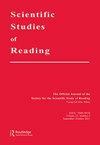Are There Binocular Advantages in Chinese Reading? Evidence from Eye Movements
IF 2.4
2区 教育学
Q1 EDUCATION & EDUCATIONAL RESEARCH
引用次数: 0
Abstract
ABSTRACTPurpose This study aims to examine whether binocular vision plays a facilitating or impeding role in lexical processing during sentence reading in Chinese.Method Adopting the revised boundary paradigm, we orthogonally manipulated the parafoveal and foveal viewing conditions (monocular vs. binocular) of target words (high- vs. low-frequency) within sentences. Forty participants (30 females, mean age = 19.9 years) were recruited to read these sentences and their eye movements were monitored.Results Through directly comparing the eye movement measures in different viewing conditions, the results indicated that compared with monocular viewing, binocular viewing resulted in shorter fixation durations, thereby facilitating lexical processing. Critically, in addition to the higher information encoding speed toward the currently fixated word in the fovea, the more efficient preprocessing of the upcoming text to the right of fixation in the parafovea may also contribute to the superiority of binocular vision over monocular.Conclusion Our findings provide the first evidence to support the binocular advantages in Chinese reading, which reveals that high-quality visual input from binocular vision plays a vital role in fluent and efficient written text reading. AcknowledgmentsThis research was supported by grant from the MOE (Ministry of Education in China) Project of Humanities and Social Sciences (18YJC190014).Disclosure statementNo potential conflict of interest was reported by the authors.Statements and declarationsThis research was supported by grants from the MOE (Ministry of Education in China) Project of Humanities and Social Sciences (18YJC190014). Correspondence should be addressed to Yanping Liu, Department of Psychology, Sun Yat-sen University, No. 135, Xingang Xi Road, Guangzhou, 510275, P. R. China; e-mail: liuyp33@mail.sysu.edu.cn.The authors declare that they have no competing financial interests.Additional informationFundingThis work was supported by the the MOE (Ministry of Education in China) Project of Humanities and Social Sciences [18YJC190014].中文阅读是否具有双目优势?眼动证据
摘要目的探讨双眼视觉在汉语句子阅读过程中对词汇加工的促进或阻碍作用。方法采用改进的边界范式,对句子中目标词(高频和低频)的准中央凹和双中央凹观看条件(单眼和双眼)进行正交操作。40名参与者(30名女性,平均年龄19.9岁)被招募来阅读这些句子,并监测他们的眼球运动。结果通过对不同观看条件下眼球运动测量结果的直接比较,结果表明,与单目观看相比,双眼观看导致注视时间更短,有利于词汇加工。至关重要的是,除了对当前注视的单词在中央凹中具有更高的信息编码速度外,对注视右侧即将到来的文本在副中央凹中进行更有效的预处理也可能有助于双眼视觉优于单眼视觉。结论本研究首次证实了双目视觉在汉语阅读中的优势,表明高质量的视觉输入对流利、高效的书面文本阅读起着至关重要的作用。本研究得到教育部人文社会科学项目(18YJC190014)的资助。披露声明作者未报告潜在的利益冲突。声明与声明本研究得到教育部人文社会科学项目(18YJC190014)资助。通讯地址:510275广州市新港西路135号中山大学心理学系刘延平;e-mail: liuyp33@mail.sysu.edu.cn.The作者声明他们没有竞争的经济利益。本研究得到中国教育部人文社会科学项目[18YJC190014]的支持。
本文章由计算机程序翻译,如有差异,请以英文原文为准。
求助全文
约1分钟内获得全文
求助全文
来源期刊

Scientific Studies of Reading
Multiple-
CiteScore
7.20
自引率
2.70%
发文量
26
期刊介绍:
This journal publishes original empirical investigations dealing with all aspects of reading and its related areas, and, occasionally, scholarly reviews of the literature, papers focused on theory development, and discussions of social policy issues. Papers range from very basic studies to those whose main thrust is toward educational practice. The journal also includes work on "all aspects of reading and its related areas," a phrase that is sufficiently general to encompass issues related to word recognition, comprehension, writing, intervention, and assessment involving very young children and/or adults.
 求助内容:
求助内容: 应助结果提醒方式:
应助结果提醒方式:


